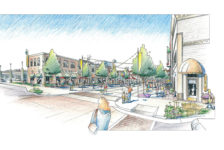An idea almost as old as cities… Green walls: Function or fad? As cities and buildings all around the world are being covered in green, we take a look at the phenomenon of green walls. The first example of green walls may be found in the Hanging Gardens of Babylon, even if they may have been more roof gardens than green walls. Later, from Scandinavia to Japan, numerous civilizations used climbing plants to cover buildings, making what is now called ‘green façades’.
Green façades were very important in the Art and Crafts and Modern style movements in Europe. For instance, in the beginning of the 20th century, the ‘Jugendstil’ movement used climbing plants (Parthenocissus tricuspidata) on the buildings to make a seamless changeover between the house and garden. In England, the Garden City movement showed great examples of green façades. William Robinson and Gertrude Jekyll designed outdoor vegetated rock walls used for screening & boundaries in gardens. You can still see such examples in Griftpark (Ultrecht, Netherlands). The use of climbing plants declined in the 30’s, due to new building techniques and people’s concern about possible consequences on wall stability. Patrick Blanc, a French botanist, is noted as the first to design the ‘modern’ pattern of green walls, with a full hydroponic system, an inert medium and numerous exotic species. His first green wall is at the Museum of Science and Industry. Green walls in North America Green façades have always been less common in North America. Nowadays, what we call ‘vertical gardens’ seems to have first been theorized in the U.S. in 1937 by Stanley Hart White which pre-dates Patrick Blanc’s work in France. His theories are now being used once again by students at University of Illinois at Urbana-Champaign.Photo credit: Patrick Blanc
Let’s focus on living walls, also called ‘biowalls’, ‘vertical gardens’ or ‘Vertical Vegetated Complex Walls’ (VCW). The simplest way is to picture it as a cliff: the synthetic medium is the interface to which the cliff growing plant species can hang onto. The hydroponic system is often used to create a succession of dry periods and humid ones. One of the more important moments in the design process of a green wall is the choosing of species: you must choose plants which will grow straight and will have beautiful lower foliage, as they will be seen from underneath. The first living walls used tropical plants but the choice is now much larger. As more recent green walls create beautiful patterns, it is becoming a new urban art.
Why green walls? They have multiple impacts on cities and citizens; they protect buildings from the effects of natural elements; they are introducing more gardens in urban areas and they can even be used to grow vegetables! Under sun exposure, a bare wall will contribute to heat conduction inside the building, making the internal building temperature rise, and contributing to the urban ‘heat island’ effect. But green walls, where the leaves of plants lose water through evapotranspiration, lower the surrounding air and building temperatures. Green walls also depress the cities temperature–they create a microclimate.  Photo credit: Patrick Blanc The Tokyo Institute of Technology proved that green walls lower the energy loss of buildings. They also prevent the creation of urban dust (partly due to the effect of wind over buildings) and absorb heavy metal particulates from the atmosphere. However, the first consequence of living walls is the creation of new green space in cities, where available space is scarce. Green
Photo credit: Patrick Blanc The Tokyo Institute of Technology proved that green walls lower the energy loss of buildings. They also prevent the creation of urban dust (partly due to the effect of wind over buildings) and absorb heavy metal particulates from the atmosphere. However, the first consequence of living walls is the creation of new green space in cities, where available space is scarce. Green
This article was originally submitted to Landscape Architects Network
Published in Blog












Pingback: Oh Grow Up: An Introduction To Living Walls And Vertical Gardening – Plant Escape
Pingback: Green Wall จากผนังตึกเก่า สู่กำแพงของนักพฤษศาสตร์ในปารีส ว่าด้วยพัฒนาการของกำแพงสีเขียว - CITY CRACKER
Pingback: Nature Green Wall | Taking Us Back to Nature
Pingback: Living Walls: At the Intersection of Green Technology and Good Design - SimpliFlying - Making Airlines Remarkable
Pingback: What is the history of the green facade? - Floral Fantasy Land